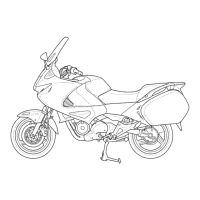
 Loading...
Loading...
Do you have a question about the Honda NT700V Deauville and is the answer not in the manual?
| Displacement | 680 cc |
|---|---|
| Bore x Stroke | 81 mm x 66 mm |
| Compression Ratio | 10.0:1 |
| Fuel System | PGM-FI electronic fuel injection |
| Starter | Electric |
| Transmission | 5-speed |
| Final Drive | Shaft |
| Front Tire | 120/70 ZR17 |
| Engine Type | Liquid-cooled, 4-stroke, SOHC, 52° V-twin |
| Max Power | 65 hp (48 kW) @ 8000 rpm |
| Ignition | Computer-controlled digital with electronic advance |
| Front Suspension | 41 mm telescopic fork, 115 mm travel |
| Rear Suspension | Single shock, Pro-Link swingarm, 120 mm travel |
| Front Brakes | 296 mm dual hydraulic disc |
| Rear Brakes | 276 mm hydraulic disc |
| Rear Tire | 150/70 ZR17 |
| Seat Height | 805 mm |
| Fuel Capacity | 19.7 liters |
| Wheelbase | 1, 475 mm (58.1 inches) |